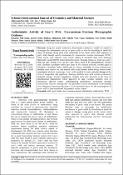Options
Anthelmintic Activity of Goat's Milk: Transmission Electron Micrographic Evidence
Journal
Scholars International Journal of Chemistry and Material Sciences
Date Issued
2018
Author(s)
Omaima Adil Najm
Mohamed Adel Elkadi
Wan Omar Abdullah
Noor Amiza Zainal Abidin
DOI
10.36348/sijcms.2018.v01i03.001
Abstract
Using the canine hookworm Ancylostoma caninum as model we aimed to investigate the anthelmintic activity of goat's milk in vitro by describing in detail the nature of damage taking place cross sectionally in the worm cuticle after exposure to goat's milk through careful observation by transmission electron microscope (TEM). Adult worms were obtained from routine culling of unwanted dogs from Selayang Municipal Council (MPS) animal detention center, Rawang, Malaysia. Fresh raw goat's milk was used. Worms were cut into 1mm3 slices, fixed in 4% glutaraldehyde, washed with 0.1sodium cacodylate buffer, post fixed in 1% osmium tetroxide, washed again in 1%sodium cacodylate buffer, dehydrated in acetone, embedded in resin, polymerized, ultrathin cross section cut and stained with uranyl acetate before being viewed under transmission electron microscope. Goat's milk resulted in worm cuticular damage in the form of irregularity and significant thinning similarly seen with cysteine proteinases mediated damage. Internal hypodermic changes were also observed in the form of mitochondrial degeneration which appeared as large vacuoles similarly seen in albendazole affected worms. Understanding anthelmintic mechanism through transmission electron micrography has provided critical information in developing novel therapies from natural products. It also provides basis for the consumption of goat's milk as functional food for parasitic worm control.
Subjects
File(s)
Loading...
Name
Anthelmintic Activity of Goat's Milk Transmission Electron Micrographic Evidence.pdf
Size
599.29 KB
Format
Adobe PDF
Checksum
(MD5):35b99313915520e44de9c7b5e2a63ef5